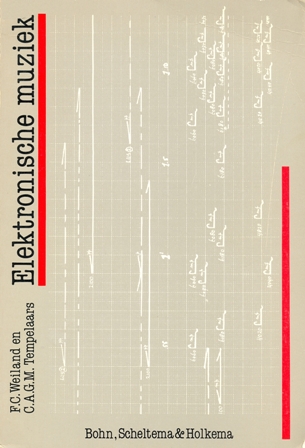F. C. Weiland: Elektronische Muziek. Muzikale en historische aspecten (1982/2008) [Dutch]
Filed under book | Tags: · electroacoustic music, electronic music, music, music history, netherlands, radio art

“Het boek Elektronische muziek werd in 1981/82 geschreven door F. C. Weiland en C.A.G.M. Tempelaars op verzoek van de uitgeverij Bohn, Scheltema en Holkema. Beide auteurs doceerden aan het Instituut voor Sonologie van de Rijksuniversiteit Utrecht, maar het boek was gericht op de belangstellende en professionele buitenwereld in het Nederlandse taalgebied. Het eerste deel, van Frits Weiland, beschrijft de muzikale en historische aspecten van de elektronische muziek, met bijzondere aandacht voor de Nederlandse situatie. Het tweede deel, van Stan Tempelaars, behandelt de signaaltheoretische aspecten. Het boek was destijds uitverkocht en niet herdrukt, en is dus al lange tijd niet meer verkrijgbaar.
Inmiddels heeft de elektronische muziek een grote ontwikkeling doorgemaakt, en is er hernieuwde belangstelling voor de geschiedenis van dit genre. Frits Weiland en NEAR/MCN wilden daarom deze historische tekst in digitale vorm toegankelijk maken. Hiermee wordt deze geschiedenis van de Nederlandse elektronische muziek voor een nieuwe generatie ontsloten. Wij hopen dat dit als inspiratie kan dienen voor nieuwe historische overzichten en verschillende interpretaties van oude en nieuwe Nederlandse elektro-akoestische muziek.
Voor deze digitale versie is zoveel mogelijk de oorspronkelijke tekst van het boek aangehouden; bij de tekstopmaak zijn kleine veranderingen aangebracht, met een nieuwe paginering. Deze tekst wordt ter inzage aangeboden; het is niet toegestaan om deze te vermenigvuldigen of in andere vormen openbaar te maken.
Voor citaten en verwijzingen moet de oorspronkelijke uitgave van Bohn, Scheltema en Holkema gebruikt worden (ISBN 90 313 0531 6); deze is te raadplegen bij Muziek Centrum Nederland (Amsterdam) of bij (universiteits-)bibliotheken.”
Originally published by Bohn, Scheltema & Holkema, Utrecht/Antwerpen, 1982
Publisher Muziek Centrum Nederland, Amsterdam, 2008
120 pages
PDF (13 MB, updated on 2016-12-23)
Comment (0)Paul Griffiths: Modern Music and After, 3rd ed (2011)
Filed under book | Tags: · composing, electroacoustic music, electronic music, music, music history, musique concrète, sound recording

Over three decades, Paul Griffiths’s survey has remained the definitive study of music since the Second World War; this fully revised and updated edition re-establishes Modern Music and After as the preeminent introduction to the music of our time. The disruptions of the war, and the struggles of the ensuing peace, were reflected in the music of the time: in Pierre Boulez’s radical reformation of compositional technique and in John Cage’s development of zen music; in Milton Babbitt’s settling of the serial system and in Dmitry Shostakovich’s unsettling symphonies; in Karlheinz Stockhausen’s development of electronic music and in Luigi Nono’s pursuit of the universally human, in Iannis Xenakis’s view of music as sounding mathematics and in Luciano Berio’s consideration of it as language. The initiatives of these composers and their contemporaries opened prospects that haven’t yet stopped unfolding.
This constant expansion of musical thinking since 1945 has left us with no singular history of music; Griffiths’s study accordingly follows several different paths, showing how and why they converge and diverge. This new edition of Modern Music and After discusses not only the music of the fifteen years that have passed since the previous edition, but also the recent explosion of scholarly interest in the latter half of the twentieth century. In particular, the book has been expanded to incorporate the variety of responses to the modernist impasse experienced by composers of the 1980s and 1990s. Griffiths then moves the book into the twenty-first century as he examines such highly influential composers as Helmut Lachenmann and Salvatore Sciarrino.
For its breadth, wealth of detail, and characteristic wit and clarity, the third edition of Modern Music and After is required reading for the student and the enquiring listener.
– Provides the most comprehensive study in English of musical composition from 1945 on
– Offers a keen examination of how important composers have responded to the constant flux of their cultural environs, both socially and technically
– Griffiths is considered by many in the field the finest writer on modern “classical” music in the English language today
Publisher Oxford University Press, 2011
ISBN 0199792828, 9780199792825
480 pages
PDF (updated on 2012-8-3)
Comment (0)Simon Emmerson (ed.): Music, Electronic Media, and Culture (2000)
Filed under book | Tags: · acoustics, electroacoustic music, electronic music, plunderphonics, radio art, sound recording, technology
Technology revolutionised the ways that music was produced in the twentieth century. As that century drew to a close and a new century begins a new revolution in roles is underway. The separate categories of composer, performer, distributor and listener are being challenged, while the sounds of the world itself become available for musical use. All kinds of sounds are now brought into the remit of composition, enabling the music of others to be sampled (or plundered), including that of unwitting musicians from non-western cultures. This sound world may appear contradictory – stimulating and invigorating as well as exploitative and destructive. This book addresses some of the issues now posed by the brave new world of music produced with technology.
Contents: Introduction, Simon Emmerson; Part One: Listening and interpreting: Through and around the acousmatic: the interpretation of electroacoustic sounds, Luke Windsor; Simulation and reality: the new sonic objects, Ambrose Field; Beyond the acousmatic: hybrid tendencies in electroacoustic music, Simon Waters; Part Two: Cultural noise: Plunderphonics, Chris Cutler; Crossing cultural boundaries through technology?, Simon Emmerson; Cacophony, Robert Worby; Part Three: New places, spaces and narratives: Art on air: a proile of new radio art, Kersten Glandien; ‘Losing touch’? the human performer and electronics, Simon Emmerson; Stepping outside for a moment: narrative space in two works for sound alone, Katharine Norman; Index.
Publisher Ashgate, 2000
ISBN 0754601099, 9780754601098
252 pages
PDF (updated on 2012-8-3)
Comment (0)
